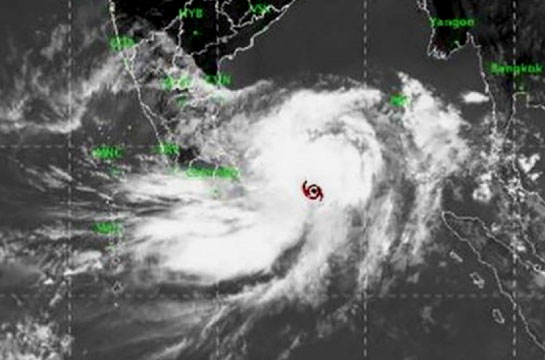DHAKA, May 3, 2019 (BSS) – The skyline turned dark in vast part of Bangladesh since midday today as cyclone Fani dubbed to be the deadliest in decades for the region started approaching Bangladesh albeit with an weakened force after ravaging India’s eastern Odisha coastlines, weather officials said.
“We expect the cyclone to enter into Bangladesh through Khulna coastlines at 6 pm and likely to take the entire night to cross the country ravaging southwestern,” met office spokesman Omar Faruque told BSS at 5 pm.
He said the impact of the approaching cyclone caused downpour in parts of
the country while the intensity of the rainfall was expected to increase in
the coming hours.
Officials at the disaster management ministry control room in Dhaka and
reports from different districts exposed to the risks of Fani wraths said
several thousand people were evacuated to safe shelters while efforts were
underway shift others to evade casualties.
Prime Minister Sheikh Hasina, now on a visit to London, meanwhile, issued
directives asking all the public and private organizations to work in a well-
coordinated way to face the cyclone.
“Work in a well-coordinated way to face the cyclonic storm Fani” and
minimize the loss of lives and property, she said in a statement issued from
London and urged the countrymen to remain prepared to face the natural
disaster.
A premier’s office spokesman said Sheikh Hasina was constantly monitoring
the situation and particularly asked the authorities concerned to bring all
the people to safer places before the Fani hit Bangladesh.
“We are prepared for the cyclone . . . army, navy, coastguards and other
agencies are ready to be called out for the disaster operation,” state
minister for disaster management Dr Enamur Rahman, meanwhile, told a news
briefing.
Disaster management ministry’s senior secretary Shah Kamal told BSS that by
the midday over half a million people were moved out to cyclone shelters or
safer places.
“In most vulnerable areas like river shoals, we are trying to help people
move out along with their valuables and cattle as well,” he said.
Kamal said the evacuees were being provided dry food while “we have enough
stock of relief materials for them”.
Reports said Red Crescent volunteers along with police and fire service
personnel using megaphone were trying to convince people to quit their home
for safer shelter.
Administrative officials said nearly two thirds of people in vulnerable
areas in Koira and Dakop coastlines, through where the cyclone was likely to
penetrate Bangladesh were evacuated.
A huge number of people were also evacuated at Satkhira’s Shyamnagar,
Ashashuni, Debhata and district Sadar were also moved to safer places as the
areas were exposed to higher risks of Fani’s wraths.
The tidal surges by now split a major embankment at Kurikatania area of
Asashuni upazila.
The latest met officice bulletin issued thid after noon said “the very
severe cyclonic storm “FANI” (PRONUNCIATION: FONI) moved northeastwards,
weakened slightly and lies over coastal odisha and adjoining northwest bay .
. . at 03 pm today (03 may 2019).
It located the storm about 445 km southwest of Mongla port, 495 km
southwest of Payra Port, 660 km west of Cox’s Bazar port and 660 km west of
Chattogram Port.”
“It is likely to move in a north-northeasterly direction further over
Odisha-West Bengal coastal area, reach Khulna and adjoining southwestern part
of Bangladesh by midnight tonight.
Khulna and adjoining southwestern coastal region of Bangladesh has been
experiencing the cyclone’s peripheral effect from morning of today.
“Maximum sustained wind speed within 74 kms of the storm centre is about
140 kph rising to 160 kph in gusts/ squalls. Sea will remain very high near
the cyclone centre,” the bulletin read.
The met office directed the Mongla and Payra ports to keep hoisted danger
signal number 7 seven in a scale of 10 covering Bhola, Barguna, Patuakhali,
Barishal, Pirojpur, Jhalokathi, Bagherhat, Khulna, Satkhira and their
offshore islands and shoals.
Chattogram Port has been advised to keep hoisted danger signal number six
covering Chattogram, Noakhali, Laxmipur, Feni, Chandpur and their offshore
islands and chars.
The bulletin asked all fishing boats and trawlers over North Bay and deep
sea to remain in shelter till further notice.
Experts said wraths of Fani of almost category 5 was expected to be lesser
in Bangladesh coasts compared to that of Odisha since it would lose its
strength on its land routes minimizing risks of high number of casualties but
it could damage standing crops and infrastructure on a vast landmass.
Reports from India suggest Fani is weakening after barreling into the
eastern coastal state of Odisha’s Puri but meteorologists there saying heavy
rains, along with strong winds, will continue throughout Friday in the state,
where more a million people were evacuated.
“After making landfall this morning, cyclone Fani has started weakening and
it’s likely to enter Bangladesh by tomorrow evening . . . But no cyclone ever
had such a long duration in April,” India Meteorological Department director
general K J Ramesh told reporters.
Two people died today after Fani slammed into eastern India sending coconut
trees flying, blew away food stands and cut off power and water with winds
gusting at speeds of up to 200 kilometres (125 miles) per hour.
The World Meteorological Organization said the storm was “one of the most
intense” in 20 years in the region.
By late Thursday in India, Fani had sustained winds of about 155 miles per
hour, nearly in the range of a Category 5 hurricane, said Derrick Herndon, an
associate researcher at the University of Wisconsin-Madison’s Cooperative
Institute for Meteorological Satellite Studies.
“It’s remarkable in terms of its wind speed,” Mr. Herndon said. “The
sustained winds are really near the top range of the winds we see in this
part of the world.”



